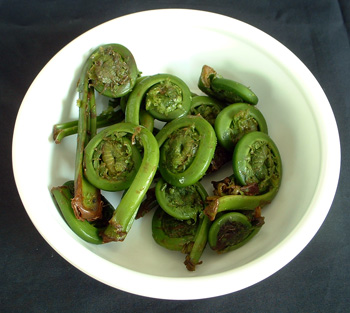 Fiddleheads
Fiddleheads© Denzil Green
A fiddlehead is the top of a fern when it first pokes through the ground in spring, curled up like the head of a fiddle. They are only available for 3 weeks in May. They are still mostly gathered from the wild, though commercial production is being explored.
They taste something like asparagus and spinach.
The most popular fern to harvest them from, and the one that is deemed the safest, is the Ostrich Fern. (see Nutrition below.) Ostrich Fern fiddleheads will have on them brown, damp “chaff” that feels papery or “fuzz” that feels like down.
Fiddleheads are very popular throughout Asia and the Pacific, particularly in Japan and in Korea, and popular in eastern parts of North America. In Asia they are cooked; in Hawaii, just parboiled.
When buying fresh fiddleheads, choose luminous, bright green ones that are small — no more than 5 cm across and 5 cm tall (2 inches x 2 inches) including the stalk.
Fiddleheads can also be bought canned.
Fresh, they only have a shelf life of about 3 days.
Cooking Tips
Choose small, firm, brightly-coloured green ones.
Trim stalks to ¼ inch (½ cm). Rub any scales or brown fuzz off, and rinse.
Bring salted water to a boil, add fiddleheads, boil for 15 minutes, or steam for 10 to 12 minutes. [1]
These are the only two acknowledged safe ways and times by food safety experts to cook fiddleheads, to leech the toxins out. Besides, they really do need the full cooking times to bring the flavour out.
Drain; discard the cooking water.
Afterwards, you can do further cooking such as sautéing, etc, or simply serve garnished with lemon, butter or a vinaigrette.
To be clear, if you are planning to sauté or otherwise cook them, you must still steam or boil them first to leach any toxins present in them out. The boiling or steaming for the prescribed times are required food safety steps.
Substitutes
Asparagus
Nutrition
The fern that most sources identify as safe is the Ostrich Fern (Matteuccia struthiopterus.) If you are picking your own, you need to make sure of the fern varieties you are harvesting, as not all are safe to eat. Do not eat any fern past the fiddlehead stage, or if the fiddlehead has started to turn purple or black [2], as it can be poisonous. Make sure you fully cook them, as there are reports of some food poisoning in some degree from undercooked fiddleheads, even Ostrich Fern fiddleheads.
Some experts advise not to eat any fiddleheads at all.
Health Canada advises to discard any steaming or simmering water that you cooked fiddleheads in, as toxins may have leeched into the water. Health Canada and the American CDC both advise the cooking time of 15 minutes for boiling, and 10 to 12 minutes for steaming, to leech out the toxins.
Storage Hints
Store in airtight container in fridge and use within 2 days. Otherwise, freeze uncooked for up to 6 months.
There are no safe, tested recommendations for home canning plain fiddleheads, but the University of Maine Extension Service has developed some recipes for pickling fiddleheads.
History Notes
In Asia, fiddleheads have been consumed for centuries. In North America, the Indians taught the newly-arrived colonists that they were edible.
Language Notes
In the Philippines, called “pako.” In Hawaii, they are called “ho’i’o.” The Hawaiian term is actually a generic one that can mean many different species of ferns, such as Diplaziums sandwichianum, Diplaziums arnotti, Athyriums meyenianum, Athyriums sandwichianum, and Diplazium escalantum.
Sources
[1] University of Maine Cooperative Extension. Bulletin #4198, Facts on Fiddleheads. 2013. Accessed May 2015 at http://umaine.edu/publications/4198e/
[2] “[avoid] fiddleheads that are purple, black, discolored or dull-looking in color.” — Barrett, L.E. Fiddle Mania. Maine’s Organic Edible Fern. Snitch LLC. 2014.
Health Canada. Food Safety Measures For Fiddleheads. April 2013. Retrieved May 2015 from http://www.healthycanadians.gc.ca/recall-alert-rappel-avis/hc-sc/2013/26809a-eng.php

